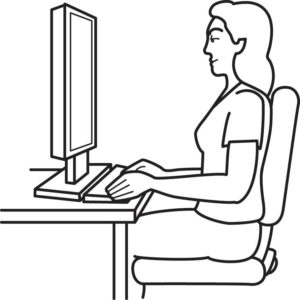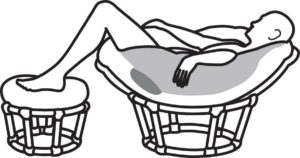
Mainstream “Posture” Review
If you google “good posture”, “proper posture” , “confident posture” a lot of the top search results are sites with much the same Type 1 instructions. For brevity sake I picked what I thought were the most common results, plus the weight of scientific authority which the organization commanded. First I’ll review the Cleveland Clinic.
I’ll indicate the problems with the Cleveland Clinics common focus as they’re listed and why the material is wrong, confusing, contradictory, unclear or unhealthy. While I’ll be mostly focused these reasons, keep in mind that all organizations do offer good information also; it just needs to be kept in the proper context, time and season.
Cleveland Clinic lists the following characteristics of proper posture, which apply to both sitting and standing:
1. Keeps bones and joints in the correct alignment so that muscles are being used properly.
2. Helps decrease the abnormal wearing of joint surfaces that could result in arthritis.
3. Decreases the stress on the ligaments holding the joints of the spine together.
4. Prevents the spine from becoming fixed in abnormal positions.
5. Prevents fatigue because muscles are being used more efficiently, allowing the body to use less energy.
6. Prevents strain or overuse problems.
7. Prevents backache and muscular pain.
8. Contributes to a good appearance. Each of the above characteristic is violated in the illustration below. Many with back pain would argue that this position does not prevent strain or overuse problems. It does not prevent backache or muscular pain. It causes them.
 These are the directions for the correct sitting position per the Cleveland Clinic:
These are the directions for the correct sitting position per the Cleveland Clinic:
- Sit up with your back straight and your shoulders back. Your buttocks should touch the back of your chair. Holding the shoulders back continuously causes imbalance and strain. The only release is to move the shoulders forward, otherwise known as “slouching”.
- All 3 back curves should be present while sitting. A small, rolled up towel or a lumbar roll can be used to help you maintain the normal curves of your back. Arbitrary. Why should the curves of your back need a towel to tell them what “normal” is. How do you or your body measure “normal”.
- Sit at the end of your chair and slouch completely.
- Draw yourself up and accentuate the curve of your back as far as possible. Hold for a few seconds.
- Release the position slightly (about 10 degrees). This is good sitting posture. Arbitrary, based on personal whim. This is a position held by muscular effort. It causes a muscle imbalance and strain.
- Distribute your body weight evenly on both hips. Without movement a position becomes harmful quickly.
- Bend your knees at a right angle. Keep your knees even with or slightly higher than your hips. Use a foot stool if necessary. Your legs should not be crossed. Without movement a position becomes harmful quickly.
- Keep your feet flat on the floor. Without movement, a position becomes harmful quickly. The word ‘keep’ implies rigidity.
- Try to avoid sitting in the same position for more than 30 minutes. Why should this be necessary if this position as stated in the above characteristics prevents the spine from becoming fixed in abnormal positions, prevents fatigue, prevents strain or overuse problems, prevents backache and muscular pain.
- At work, adjust your chair height and work station so you can sit up close to your work and tilt it up at you. Rest your elbows and arms on your chair or desk, keeping your shoulders relaxed. Lesson # 1, above, instructed us to keep “shoulders back”. How can they be held back and relaxed at the same time. Confusing, contradictory.
- When sitting in a chair that rolls and pivots, don’t twist at the waist while sitting. Instead, turn your whole body. This will extend the length of time until injury from too much time in a straight backed chair becomes clinically significant.
- When standing up from the sitting position, move to the front of the seat of your chair. Stand up by straightening your legs. Avoid bending forward at your waist. Immediately stretch your back by doing 10 standing backbends. Why would you need to do backbends if, as per Cleveland Clinics characteristics # 5,6,7 state: “this position prevents fatigue because muscles are being used more efficiently, allowing the body to use less energy, prevents strain or overuse problems, prevents backache and muscular pain”.
- Sit up with your back straight and shoulders back. Your buttocks should touch the back of your chair.

The young spine sulks
- Both statements imply holding. Confusing to me in that just exactly where is it that your back is straight and your shoulders are back. All instructions contradict characteristics as stated above. Confusing, unbalanced, contradictory, vague, arbitrary.

